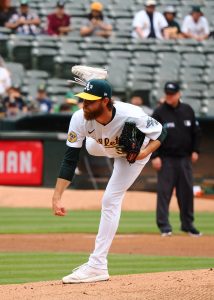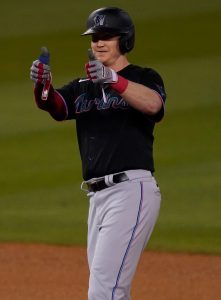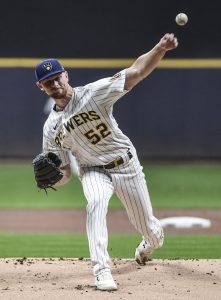This week, we investigate a mix of prospects at a wide range of levels.
Five Big Hype Prospects
Oneil Cruz, 23, SS, Pirates (MLB)
(AAA numbers) 247 PA, 9 HR, 11 SB, .232/.336/.422
When Tim Dierkes suggested I run this column, Cruz was his first example of the type of player he wanted to see covered. I’d previously written a fantasy column about “Peripheral Prospects” in this same format covering lesser-known guys like Ken Waldichuk and Brett Kerry. It’s only fitting to touch upon Cruz one more time. While his Triple-A numbers don’t jump off the page, he eventually settled in to the level. Since early-May, he’s batted .280/.374/.520 with an 11.4 percent walk rate and 17.7 percent strikeout rate. Reportedly, he was disappointed by his initial demotion, and it contributed to his April-long slump.
Since rejoining the Majors, Cruz is 4-for-18 with a stolen base. In four games, he’s already hit four balls over 100-mph, including two lasers over 110-mph. This is consistent with his track record. Cruz is built like a young Aaron Judge, and he hits the ball nearly as hard. His typical angle of contact is geared towards ground ball and line drive contact which could limit his home run production. When he does lift the ball, you can expect to see it soar. Anytime he’s in the lineup, Cruz is one of the most fascinating players in the league.
C.J. Abrams, 21, SS, Padres (MLB)
(AAA numbers) 151 PA, 7 HR, 10 SB, .314/.364/.507
Like Cruz, Abrams had a previous brief taste of the Majors and recently returned for four games. He’s 2-for-15 with one strikeout. Unlike Cruz, his exit velocities have been outright poor – just 81.8-mph. Abrams’ selection to the Padres roster followed on the heels of a particularly torrid multi-week stretch. He hit .398/.442/.519 over his last 95 Triple-A plate appearances. Included in the fun were four home runs, a 5.3 percent walk rate, and an 11.6 percent strikeout rate.
Such production indicated immediate readiness, especially for a prospect of Abrams’ caliber who scouts adore. If there’s a shortcoming in his profile, it’s that he doesn’t walk. It’s not necessarily an issue of discipline. He expands the zone in part because his speed has allowed him to still reach base in the minors. It’s possible he’ll learn to lay off marginal pitches in the Majors to improve his outcomes. If he does, he’ll flower into a high-quality leadoff hitter. There are still questions about his eventual defensive home – and not only because he has to share a field with Fernando Tatis Jr.
The worst-case scenario for Abrams is as an over-aggressive, contact-oriented slasher who plays all over the field. Between injuries and his incredible talent, we haven’t seen Abrams make many adjustments as a professional.
Anthony Volpe, 21, SS, Yankees (AA)
270 PA, 9 HR, 25 SB, .233/.326/.427
Over the offseason, I was virtually cornered by several Yankees fans who not-so-calmly explained that Volpe was the best prospect since Mike Trout. To the glee of everybody who loves to hate the Yankees, he performed particularly poorly until mid-May. Through May 17, he slashed a meager .170/.297/.330. Optimists cited four reasons he would rebound. First, the talent remained evident. He was working counts (13.8 percent walk rate). His .195 BABIP indicated poor luck. Lastly, he wasn’t the first prospect to wilt in chilly early-season weather.
As the calendar has heated up, so too has Volpe. He’s slashing .292/.356/.517 since May 18, a span of 132 plate appearances. He’s also putting more balls in play (6.8 percent walk rate, 15.9 percent strikeout rate) with a normal .319 BABIP. Volpe is on the shortlist for top prospect remaining in the minors. He’s also making a strong case for promotion to Triple-A – possibly by the end of this month.
Zac Veen, 20, OF, Rockies (A+)
258 PA, 8 HR, 25 SB, .259/.368/.440
The Rockies don’t exactly have an illustrious reputation with prospects. It’s nice to see Veen continue to perform to his draft pedigree. Scouting reports uniformly express concern about his hit tool playing against elite competition. While he possesses considerable raw power, his swing has qualities that some might describe as grooved. Such hitters can still succeed in the Majors. Billy Wagner once ridiculed Pat Burrell’s one-path swing (after allowing a home run). Joc Pederson might be a more relevant groovy comparison as a left-handed hitter with a pretty, loopy swing.
In any event, Veen is on track to spend some time in Double-A this season and debut either late in 2023 or early 2024. He works counts (14.3 percent walk rate) though he is also whiff prone (23.6 percent strikeout rate, 14.3 percent swinging-strike rate). While he’s 25-for-26 on the basepaths this season, it’s not clear if Veen will continue to run as he moves up the organizational ladder.
Joey Wiemer, 23, OF, Brewers (AA)
267 PA, 15 HR, 20 SB, .272/.348/.531
A divisive prospect, Wiemer is gaining steam as one of those guys who might succeed – perhaps even thrive – despite glaring flaws. He changed his mechanics heading into 2021 and unlocked massive in-game power. He launched 27 home runs in 472 plate appearances last season before tearing through the Arizona Fall League – one home run and a .467/.568/.667 triple-slash in 30 plate appearances.
There’s question if the hit tool will play in the Majors, but the power is evident enough to easily support a low-average approach. A worst-case scenario might look something like Adolis Garcia with plate discipline. Or Adam Duvall with discipline and an eagerness to run. He sells out for pull-side, fly-ball contact. He’s posted high BABIPs at every level, but this is a hitting profile that usually yields low BABIPs due to a cacophony of pulled grounders and easy fly outs. We should see him tested in Triple-A before long. Milwaukee might even need his help in the Majors late in the season if they don’t add outfield depth at the trade deadline.
Having watched him play several games, the energy he gives off evokes Bryce Harper.
Five More
Gunnar Henderson, Orioles (21): Last week’s lead BHP (that’s Big Hype Prospect), I noted Henderson would soon jump from around the 50th prospect to somewhere in the Top 10 as listmakers prepare their midseason updates. Since then, Baseball Prospectus’ Jarrett Seidler indicated Henderson might be the top prospect left in the minors. A highly-placed source at another major industry outlet confirmed Henderson is on a shortlist of about five players for their top prospect. As I understand it, this excludes all prospect-eligible players currently in the Majors like Michael Harris, Oneil Cruz, and C.J. Abrams.
Eury Perez, Marlins (19): Currently shredding Double-A hitters, Perez is perhaps the most-precocious pitching prospect since Julio Urias. While Urias’ development was eventually delayed by injuries, Perez remains both healthy and effective. Most of what I would say about Perez was gleaned from the Marlins system update posted to FanGraphs earlier today. So, I’ll let you read what Eric Longenhagen has to say directly.
Jeter Downs, Red Sox (23): Downs made his debut recently, struck out three times in four plate appearances, and was promptly optioned back to Triple-A. Once a fairly well-regarded prospect, he’s fallen off the map since joining the Red Sox in the Mookie Betts trade. He still possesses tantalizing power and speed along with decent plate discipline. Unfortunately, there’s a ton of swing-and-miss in the profile; the kind that’s readily exploitable by seasoned pitchers. The best-case scenario these days is a sort of Dylan Moore-like outcome.
Brett Baty, Mets (22): Baty was, for me, the most visibly impressive prospect in the Arizona Fall League. Like Volpe, he had a chilly start to his Double-A campaign – his second visit to the level. He currently has a 14-game hitting over which he’s tamed his strikeout rate and pulled his season-long batting line up to an above-average .282/.372/.450 performance. Like the most of the other Double-A bats we’ve profiled today, he’s seemingly on the cusp of a promotion.
Noelvi Marte, Mariners (20): Two weeks ago, I noted some in the scouting biz had indicated Marte’s early-career dominance might be linked to physical traits that won’t necessarily scale as he advances to higher levels. In plain English, the boy got big young. Last week, I issued something of a retraction because I’d misplaced my source. Since then, I rediscovered the initial note, and it comes from a highly reputable source with access to dozens of scouts. All of this is to say that Marte doesn’t seem to be the second-coming if you buy into this early-development narrative. Not everybody does! This has been the most contentious take to appear in BHP. I look forward to fomenting more discussion about Marte. For what it’s worth, his June-long slump has continued. He hit .214/.241/.250 over the last week and is at .191/.257/.324 for the month.



